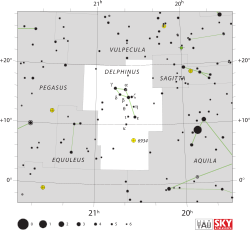| Observation data Epoch J2000 Equinox J2000 | |
|---|---|
| Constellation | Delphinus |
| Right ascension | 20h 39m 07.78430s [1] |
| Declination | +10° 05′ 10.3383″ [1] |
| Apparent magnitude (V) | 5.05 [2] |
| Characteristics | |
| Spectral type | G1IV + ? + K2IV [3] |
| U−B color index | 0.235 [4] |
| B−V color index | 0.69 [4] |
| Astrometry | |
| Radial velocity (Rv) | -53.51 [2] km/s |
| Proper motion (μ) |
RA: 323.83
[1]
mas/
yr Dec.: 21.80 [1] mas/ yr |
| Parallax (π) | 33.0268 ± 0.1631 mas [5] |
| Distance | 98.8 ± 0.5
ly (30.3 ± 0.1 pc) |
| Absolute magnitude (MV) | 2.7 [6] |
| Orbit [6] | |
| Period (P) | 45 ± 5 yr |
| Semi-major axis (a) | 0.520 ± 0.030″ |
| Eccentricity (e) | 0.8 ± 0.4 |
| Inclination (i) | 107 ± 18° |
| Longitude of the node (Ω) | 326 ± 17° |
| Periastron epoch (T) | B 1971.2 ± 1.8 |
|
Argument of periastron (ω) (secondary) | 8 ± 34° |
| Details [7] | |
| κ Del Aa | |
| Mass | 1.43 M☉ |
| Luminosity | 8.3 L☉ |
| Surface gravity (log g) | 3.69 cgs |
| Temperature | 5,643 K |
| Metallicity [Fe/H] | +0.01 dex |
| Rotational velocity (v sin i) | 1.77 km/s |
| Age | 3.1 Gyr |
| κ Del Ab | |
| Mass | 0.4±0.2 [6] M☉ |
| Other designations | |
| Database references | |
| SIMBAD | data |
κ Delphini (Latinised as Kappa Delphini, abbreviated to κ Del or kappa Del) is a binary star system in the constellation Delphinus. It is faintly visible to the naked eye, with an apparent magnitude of 5.05. [2] It is located about 98.8 light-years away, based on its parallax. [1]
Kappa Delphini is an astrometric binary. The primary star is an early G-type subgiant star. It has a mass 1.61 times that of the Sun, and is 6.8 times more luminous. The companion star regularly perturbs the G-type primary star primary, causing it to wobble around the barycenter. From this, an orbital period of 45 years has been calculated. [6] The secondary star is a low-mass star, at only 0.4 M☉. [6]
A third star is 12th magnitude ADS 14101 B, 10 ″ away in 2001, but it is a background object. HD 196794 is an 8th magnitude K2 subgiant 214″ away is at the same distance as κ Delphini and shares a common proper motion. [6]
References
- ^ a b c d e van Leeuwen, F. (2007). "Validation of the new Hipparcos reduction". Astronomy and Astrophysics. 474 (2): 653–664. arXiv: 0708.1752. Bibcode: 2007A&A...474..653V. doi: 10.1051/0004-6361:20078357. S2CID 18759600. Vizier catalog entry
- ^ a b c d "* kap Del". SIMBAD. Centre de données astronomiques de Strasbourg. Retrieved 26 December 2016.
- ^ Eggl, S.; Pilat-Lohinger, E.; Funk, B.; Georgakarakos, N.; Haghighipour, N. (2012). "Circumstellar habitable zones of binary-star systems in the solar neighbourhood". Monthly Notices of the Royal Astronomical Society. 428 (4): 3104. arXiv: 1210.5411. Bibcode: 2013MNRAS.428.3104E. doi: 10.1093/mnras/sts257.
- ^ a b Mermilliod, J.-C. (1986). "Compilation of Eggen's UBV data, transformed to UBV (unpublished)". Catalogue of Eggen's UBV Data: 0. Bibcode: 1986EgUBV........0M.
- ^ Brown, A. G. A.; et al. (Gaia collaboration) (August 2018). "Gaia Data Release 2: Summary of the contents and survey properties". Astronomy & Astrophysics. 616. A1. arXiv: 1804.09365. Bibcode: 2018A&A...616A...1G. doi: 10.1051/0004-6361/201833051. Gaia DR2 record for this source at VizieR.
- ^ a b c d e f Gontcharov, G.A.; Kiyaeva, O.V. (2010). "Photocentric orbits from a direct combination of ground-based astrometry with Hipparcos II. Preliminary orbits for six astrometric binaries". New Astronomy. 15 (3): 324–331. arXiv: 1606.08182. Bibcode: 2010NewA...15..324G. doi: 10.1016/j.newast.2009.09.006. S2CID 119252073.
- ^ Niedzielski, A.; Deka-Szymankiewicz, B.; Adamczyk, M.; Adamów, M.; Nowak, G.; Wolszczan, A. (2016). "The Penn State - Toruń Centre for Astronomy Planet Search stars". Astronomy and Astrophysics. 585: A73. Bibcode: 2016A&A...585A..73N. doi: 10.1051/0004-6361/201527362.
